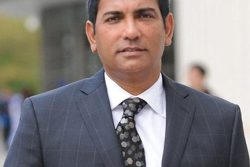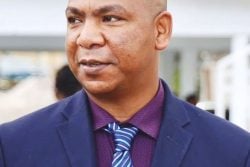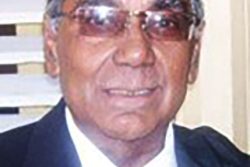 The University of Guyana (UG) has had a long association with art, including literature, music and drama, like most tertiary institutions, but specifically with fine arts.
The University of Guyana (UG) has had a long association with art, including literature, music and drama, like most tertiary institutions, but specifically with fine arts.
Some of this is historical, and cuts across academic, practical, critical recognition, and the work of staff and students. The institution’s contribution to art includes exhibitions, the output of resident artists, critical publications, inter-varsity exchanges, and academic programmes, as the association has even transcended national boundaries. The accounts show a robust track record in artistic involvement.
It can be said that art at UG began with Stanley Greaves. But there are other interesting reports. The university’s oldest and largest lecture hall has played host to the two most important pieces of art of historical interest on the Turkeyen Campus. The older and more illustrious of them no longer hangs in its former place, but it was the first prominent national work of art to have graced the walls of the campus and set a pattern of UG’s association with excellent art. No records are to be found of exactly when it was first hung in the lecture theatre, whether it was a gift, and if so, bestowed by whom or how it got there. But it decorated the stage and served as a permanent backdrop for several years from the 1970s to the 1990s.
This work was a Rainforest Tapestry by Marjorie Broodhagen, among the nation’s greatest and the leading woman artist in Guyana at that time. Broodhagen, who was part Amerindian extraction, was known for a range of art, including that of indigenous influence and inspiration. This tapestry, crafted on heavy fabric of dark green colour, to create the visual effect of a deep rainforest with interplays of silver, gold and orange-brown, was one of them. It must have been quite an honour for UG to have displayed the work of such an important and revered national artist, a woman who strode like a colossus over British Guianese pre-independence art, bridging the period into post-independence art of the 1970s.
The second historical artwork still stands in its bold and semi-erotic glory in the same George Walcott Lecture Theatre (named after the university’s first Guyanese vice-chancellor). This piece is an imposing polished wood sculpture of realism, a graphic and sensual depiction of two nude lovers in a voluptuous embrace titled “The Royal Slaves”, done by an Englishman named Arthur Goodland. The artwork is based on the Surinamese legend of Prince Oroonoko and Princess Imoinda, royal Africans tricked into slavery.
Goodland was a chemical engineer who came to Guyana as an administrator for the Bookers sugar estates in the 1960s. He was the colleague and friend of poet Ian McDonald, who has written quite an interesting, often amusing, account of his encounters with Goodland in Georgetown. McDonald’s “Extraordinary People: Arthur Goodland” (Sunday Stabroek, April 18, 2021) included details of the artist’s work on the sculpture which is more than 15 feet high. It related that it took the artist three years to complete and it “was gifted to the nation”. It now stands displayed in the main George Walcott lecture theatre of the University of Guyana.
The university also has a connection with Guyana’s greatest archaeologist and anthropologist, the artist Denis Williams. The sources report that a number of attempts to get him appointed at the institution never materialised, but Williams was a member of the university in another way. He graduated with an MA in Guyanese History to become one of the most distinguished graduates of that programme, and this historical connection can only serve to heighten UG’s reputation in the arts.
The most visible and outstanding public art work on the Turkeyen Campus is one with literary connections and includes inputs from two of Guyana’s outstanding artists. It was done by three painters, two of whom were lecturers in art at the institution, while the third was their student. “Palace of the Peacock: Homage to Wilson Harris” (2009) by George Simon, Philbert Gajadhar (lecturers) and Anil Roberts (final year student) is a mural of high quality on the wall at the entrance to the Faculty of Education and Humanities and just outside the Division of Creative Arts. It was done to pay tribute to Harris, the famous Guyanese novelist and theorist, and as a gift to the university.
The mural was inspired by Harris’s groundbreaking novel Palace of the Peacock (1960) and is excellent intertextual discourse. It dialogues with the novel’s preoccupations such as rebirth, the rainforest, riverain landscape, and a motif that plays on the splendour of the peacock’s tail with its dozens of ‘eyes’. This painting, standing prominently as it does outside of a building within which the arts are studied, may be symbolic and is a visible representative of the university’s association with the arts.
Greaves, meanwhile, was the founder of the university’s art programme, and the creator and first coordinator of the Division of Creative Arts in 1975. He designed the minor in art and the first full courses in painting, drawing and sculpture. Of importance is the fact that the institution’s academic study and investigation were inaugurated by an academic who also happened to be among the nation’s foremost artists. This tone was set by Greaves and famously followed in the ensuing years.
The university had its first professor in Doris Rogers, who was a painter and a professor in Art Education, responsible for advancing the academic programme started by Greaves and initiating a few of the other areas of development for which the faculty became known. The first bachelor’s degree in art was offered in 1991, when the articulation with the Burrowes School of Art came into practice. Art Education was introduced in the curriculum and a collaboration developed between the then Faculty of Arts and the Faculty of Education in the training of teachers. It was Prof Rogers who arranged the inter-varsity exchanges and the UG student exhibitions in foreign universities.
This expansion opened the way for a programme that attracted and that continued to be associated with the nation’s best artists. One of these was extraordinary painter Bernadette Persaud who joined the institution to enlarge its reputation and strengthen its programmes. Persaud’s renown escalated with her innovation, which included the transformation of landscape painting in symbolist explorations and intertextual engagements with the poetry of Martin Carter. Her research and symbolism expanded into East Indian art and religious interrogation of both Hinduism and Islam as the application of research to painting deepened at UG. Other UG artists were to follow in this, including Philbert Gajadhar, Winslow Craig and Akima McPherson.
Another of the illustrious names emerging in the university’s Division of Creative Arts was George Simon, who was able to move the institution’s engagement with art in diverse directions because of his qualifications as an archaeologist and his remarkable excursions into Amerindian art and mythology. He also functioned as a member of the Amerindian Research Unit and helped to move UG into a number of important archaeological expeditions in partnership with other universities. Simon was known for his ventures into mythology and shamanism and Amerindian art influenced by both of these as well as by the rainforest and animism, among other things. He further expanded the university’s reputation by winning the prestigious Anthony N Sabga Caribbean Award for Excellence.
UG continued to be known as a place where the best artists resided with the continued presence and work of Winslow Craig, one of the most gifted sculptors to emerge in Guyana. While he also worked in Amerindian art, Craig was innovative in other areas including his own highly polished forms, abstract symbolism and work in metals, acquired from research in New Zealand. His presence strengthened the programme in Sculpture, making it easier for students to major in that discipline.
Craig also contributed, along with other artists like McPherson, Gajadhar and Michael Khan, to the winning of prizes and awards by UG staff. Gajadhar also advanced research and distinguished himself in at least two areas of investigation which resulted in important suites of paintings, namely, the untouchables of India and the sugar estates – more famously, the cane cutters. He also developed in the area of Art Education, a specialist area of Khan.
McPherson distinguished herself by winning one of the top awards in the annual Guyana Visual Arts Competition and Exhibition (GVACE) on two occasions with art work of particular originality. She advanced herself as an art historian and is leading the development of that field in the UG curriculum, but in the meantime she has built quite a reputation for producing art in the interest of women’s issues including domestic violence. She has developed abstract art in these areas, in addition to skill as a curator. As a prominent national artist McPherson has made considerable contributions to the Guyana Association of Women Artists.
Khan, popularly known as a storyteller and stage performer, made great strides while at UG in not only Art Education, which is his academic specialisation, but in textile and in Creative Craft, an area in which he won two top awards in the GVACE. He has helped to broaden the areas of study available to students while substantially advancing his reputation as a national artist.
The University of Guyana’s newest artist on staff is Elodie Cage-Smith, who has already made a name for herself in painting, jewellery and other craft. She is a recent graduate who demonstrates the strength of the UG art programme because of the way students and former students have distinguished themselves. Cage-Smith has already produced breathtaking work, particularly in abstract paintings based on historical research, including slavery. She is a fast rising academic who has published. Cage-Smith is also one of the lecturers who won prizes in GVACE.
Students are part of the outcome of the UG Art programme, along with the great strength in the artistic output and excellence by staff. Two of the recent graduates worthy of mention are Pe-kah–lah James and Chelsea Ramotar. James has advanced as a tutor, but has already made a mark as an artist on the national/international scene. In all these ways the University of Guyana has exhibited an outstanding association with art.









